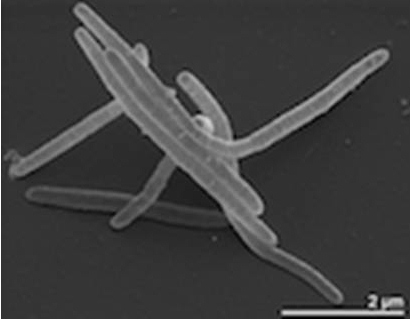Enterococcus Avium: Difference between revisions
| Line 33: | Line 33: | ||
==Pathology== | ==Pathology== | ||
E. <i> | E. avuim<i> is said to be a nosocomial pathogen, meaning that it prefers a hospital like environment and when found in the human body it causes many infections of the abdominal/ urinary region. | ||
==References== | ==References== | ||
Revision as of 02:28, 3 May 2012
A Microbial Biorealm page on the genus Enterococcus Avium
Classification
Higher order taxa

Domain: Bacteria
Phylum: Firmicutes
Class: Bacilli
Order: Lactobacillales
Family: Enterococcaceae
Genus: Enterococcus
Species
E. avium
Description and significance
Enterococcus avium is a rare infection in humans, but only a few reported cases are known. In such cases, E. avium may be vancomycin-resistant Enterococcus avium, and is referred to as VREA.VREA cases have been successfully treated with linezolid.E.avium is a Gram positive, non-pigmented, non-spore forming bacterium,usually in the shape of a sphere or oval, circular, and smooth colonies.
Genome structure
Enterococcus avium contains one circular chromosome about 3445 kb in size. The sequence of 16s rRNA gene is most closely related to E. durans, with both containing six rxn operons. The whole genome has not been sequenced yet. The VREA case receives its resistance to vancomycin due to a gene called the vanA gene. There are genes that scientists have isolated from many species of enterococci (agg, gelE, ace, cylLLS, esp, cpd, fsrB) that are considered virulence factors. Analysis of the genome for E. avium indicates 35-40% G+C content of the DNA.
Cell and colony structure
Enterococcus avium is a gram positive bacterium, roughly 0.6-2.0 µm in size. It usually takes place in pairs or chains. The cells are spherically and ovoid shaped, and grow in numerous colonies consisting of thousands if not hundreds of thousands bacterium. When grown on a nutrient agar the colonies are smooth, circular and have no pigment. E. avium are non-motile bacterium . One case of VREA a women had 100,000+/mm of E. avium in her urine sample.
Metabolism
E. avuim is a facultative anaerobe, meaning it can make ATP when oxygen is present, but can also switch and ferment. The bacterium is a chemoorganotroph , that ferments many carbohydrates with a main production of L(+) lactic acid. The bacterium tests negative to catalase. The optimal temperature for growth is 37ºC, but can also grow at 10º and 45ºC. The best growth pH is 9.6 and were identified by way of growth in 6.5% NaCl broth and hydrolysis of esculin on bile-esculin agar. Folinic acid is required for growth. Arginine and starch are not hydrolyzed. E. avium produces H2S, and nitrate is not reduced. E. avium can survive heating at 60ºC, and is very well known for its production of α-galactosidase. E. avium is said to be a nosocomial pathogen, meaning that it prefers a hospital like environment. Most cases of E. avium are known to start outside of a hospital, but increase in colony size when hospitalized.
Ecology
The habitat of this pathogen has been noted to be multiple possibilities, but some of the common places it colonizes are, the gastrointestinal tract, urinary tract, digestive, and in general the abdominal region. It’s optimal growth occurs at 37ºC and go as low as 10ºC and as high as 60ºC. The optimal growth pH is 9.6, but usually is characterized between 4 and 5. In two cases of E. avium being studied both patients were complaining of abdominal pain, and later discovered that the specific type of Enterococcus was (VREA), which is Vancomycin Resistant E. avium. Vacomycin is a type of drug that is used to treat colitis, which is inflammation of the intestine, due to bacteria. VREA receives its resistance to Vancomycin due to the presence of the vanA gene. Since this is most commonly found in the gastro intestinal and urinary tracts, the pathogen needs a warmer environment. It can also survive harsh conditions such as enzymes, acids and other intestinal and urinary fluids.
Pathology
E. avuim is said to be a nosocomial pathogen, meaning that it prefers a hospital like environment and when found in the human body it causes many infections of the abdominal/ urinary region.
References
[[2]Pagani, I.; Chertkov, O., Lapidus, A., Lucas, S., Glavina Del Rio, T., Tice, H., Copeland, A., Cheng, J., Nolan, M., Saunders, E., Pitluck, S., Held, B., Goodwin, L., Liolios, K., Ovchinnikova, G., Ivanova, N., Mavromatis, K., Pati, A., Chen, A., Palaniappan, K., Land, M., Hauser, L., Jeffries, C., Detter, J., Han, C., Tapia, R., Ngatchou, O., Rohde, M., Göker, M., Spring, S., Sikorski, J., Woyke, T., Bristow, J., Eisen, J., Markowitz, V., Hugenholtz, P., Klenk, H., & Kyrpides, N. (2011). Complete genome sequence of Marivirga tractuosa type strain (H-43T). Standards In Genomic Sciences, 4(2). doi:10.4056/sigs.1623941]
[[3]Yoon, Jaewoo, Naoya Oku, Sanghwa Park, Atsuko Katsuta, and Hiroaki Kasai. (2011) "Tunicatimonas Pelagia Gen. Nov., Sp. Nov., a Novel Representative of the Family Flammeovirgaceae Isolated from a Sea Anemone by the Differential Growth Screening Method." Antonie Van Leeuwenhoek 101.1: 133+, doi: 10.1007/s10482-011-9626-6]
[[4]Nedashkovskaya, O. I., M. Vancanneyt, S. B. Kim, and K. S. Bae. "Reclassification of Flexibacter Tractuosus (Lewin 1969) Leadbetter 1974 and 'Microscilla Sericea' Lewin 1969 in the Genus Marivirga Gen. Nov. as Marivirga Tractuosa Comb. Nov. and Marivirga Sericea Nom. Rev., Comb. Nov." International Journal Of Systematic And Evolutionary Microbiology 60.8 (2010): 1858-863. doi: 10.1099/ijs.0.016121-0]
Edited by Edited by Kayla Ferrara a student of Dr. Lisa R. Moore, University of Southern Maine, Department of Biological Sciences, [5]
